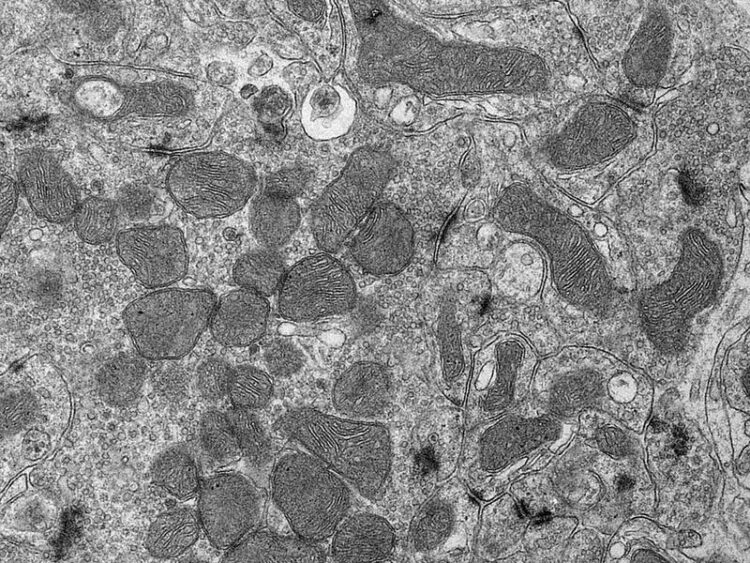DNA building blocks regulate inflammation

Electron micrograph of mitochondria in a nerve cell.
(c) Hans-Georg Sprenger
Mitochondria are the energy suppliers of our cells and have their own genetic material, which triggers an inflammatory response when released into the cell’s interior. Some cardiac and neurodegenerative diseases as well as the ageing process are linked to the mitochondrial genome. Researchers at the Max Planck Institute for Biology of Ageing and the CECAD Cluster of Excellence in Ageing research have investigated the reasons for the release of mitochondrial genetic material and found a direct link to cellular metabolism: when the cell’s DNA building blocks are in short supply, mitochondria release their genetic material and trigger inflammation.
Shortage of DNA building blocks in the cell releases mitochondrial DNA
Our body needs energy – for every metabolic process, every movement and for breathing. This energy is produced in tiny components of our body cells, the so-called mitochondria. Unlike other cell components, mitochondria have their own genetic material, mitochondrial DNA. However, in certain situations, mitochondria release their DNA into the interior of the cell, causing a reaction from the cell’s own immune system and being associated with various diseases as well as the ageing process. The reasons for the release of mitochondrial DNA are not yet known.
Shortage of DNA building blocks triggers inflammatory reaction
To answer the question of when mitochondria release their DNA, researchers at the Max Planck Institute for Biology of Ageing have focused on the mitochondrial protein YME1L, which owes its name to yeast mutants that release their mitochondrial DNA – yeast mitochondrial escape 1. “In cells lacking YME1L, we observed the release of mitochondrial DNA into the cell interior and a related immune response in the cells”, said Thomas MacVicar, one of the study’s two first authors. Closer examination revealed a direct link to the building blocks of DNA. “If the cells lack YME1L, there is a deficiency of DNA building blocks inside the cell”, Thomas MacVicar describes. “This deficiency triggers the release of mitochondrial DNA, which in turn causes an inflammatory response in the cell: the cell stimulates similar inflammatory reactions as it does during a bacterial or viral infection. If we add DNA building blocks to the cells from the outside, that also stops the inflammation.”
New therapeutic approaches based on the metabolism of DNA building blocks
The discovered link between the cellular inflammatory response and the metabolism of DNA building blocks could have far-reaching consequences, explains Thomas MacVicar: “Some viral inhibitors stop the production of certain DNA building blocks, thereby triggering an inflammatory response. The release of mitochondrial DNA could be a crucial factor in this, contributing to the effect of these inhibitors.” Several ageing-associated inflammatory diseases, including cardiac and neurodegenerative diseases, as well as obesity and cancer, are linked to mitochondrial DNA. The authors hope that modulating the metabolism of DNA building blocks will offer new therapeutic opportunities in such diseases.
Wissenschaftliche Ansprechpartner:
Prof. Dr. Thomas Langer
Max Planck Institute for Biology of Aging, Cologne
Tel.: +49 (0)221 37 970 500
Email: thomas.langer@age.mpg.de
Originalpublikation:
Hans-Georg Sprenger *, Thomas MacVicar *, Amir Bahat, Kai Uwe Fiedler, Steffen Hermans, Denise Ehrentraut, Katharina Ried, Dusanka Milenkovic, Nina Bonekamp, Nils-Göran Larsson, Hendrik Nolte, Patrick Giavalisco and Thomas Langer.
Cellular nucleotide imbalance triggers mitochondrial DNA-dependent innate immunity.
Nature Metabolism, 2021.
Online: 26.04.2021, DOI: 10.1038/s42255-021-00385-9
URL: https://dx.doi.org/10.1038/s42255-021-00385-9
* Equal first authors
Media Contact
All latest news from the category: Life Sciences and Chemistry
Articles and reports from the Life Sciences and chemistry area deal with applied and basic research into modern biology, chemistry and human medicine.
Valuable information can be found on a range of life sciences fields including bacteriology, biochemistry, bionics, bioinformatics, biophysics, biotechnology, genetics, geobotany, human biology, marine biology, microbiology, molecular biology, cellular biology, zoology, bioinorganic chemistry, microchemistry and environmental chemistry.
Newest articles

Silicon Carbide Innovation Alliance to drive industrial-scale semiconductor work
Known for its ability to withstand extreme environments and high voltages, silicon carbide (SiC) is a semiconducting material made up of silicon and carbon atoms arranged into crystals that is…

New SPECT/CT technique shows impressive biomarker identification
…offers increased access for prostate cancer patients. A novel SPECT/CT acquisition method can accurately detect radiopharmaceutical biodistribution in a convenient manner for prostate cancer patients, opening the door for more…

How 3D printers can give robots a soft touch
Soft skin coverings and touch sensors have emerged as a promising feature for robots that are both safer and more intuitive for human interaction, but they are expensive and difficult…





















